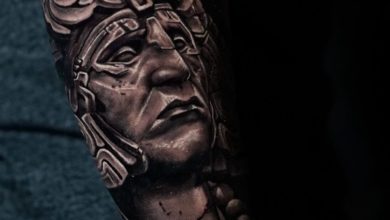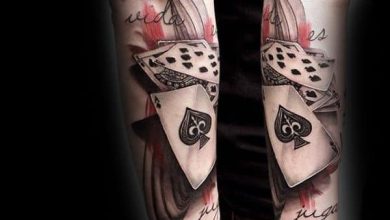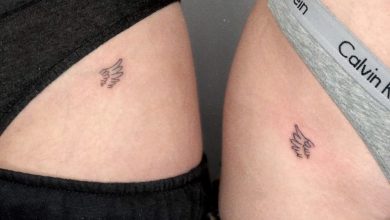11 Best Mexican Tattoos for Women [Symbolism & Ideas]

Are you looking for the best Mexican tattoos for women?
You’ve come to the right place! 👋 my name is shelley, and i have been traveling alone and living in mexico since april 2018. i fell in love with the country and wanted to get a mexico tribute tattoo after my first year living here.
I did a lot of research on designs, but I settled on the mermaid from the Mexican card game called the loteria. these are popular tattoos to get, and there are 54 cards in the set, so if you feel like it, you could even do a full lottery-themed sleeve!
…but we’ll make it to the lottery.
Mexican tattoo: Mexican tattoos for women
embroidered tattoos
This beautiful style of tattoo gives the optical illusion that your skin has been embroidered. One of the most popular ways to represent this is through the Otomi pattern, which is associated with the Otomi ethnic groups of central Mexico.
Mexican embroidery-style tattoos (pronounced bore-dad-oh, and meaning “embroidery”) are commonly done with traditional folklore elements, such as hummingbirds, deer, other animals, and flowers.
This aesthetic is indicative of the style of embroidery found on everything from wall hangings and tablecloths to the traditional Mayan huipil (pronounced wee-peel).
The huipil is a pre-Hispanic tunic-style garment, still worn by Mayan women today in Mexico and Central American countries such as Guatemala.
You will see huipiles especially in the Mayan regions of Mexico, such as the Yucatan Peninsula (less in the tourist meccas of Cancun and Tulum, but definitely in places like Mérida) > and valladolid). Mayan women in the state of chiapas, and sometimes in the state of oaxaca, also wear a huipil.
Mexican tattoo: Mexican tattoos for women
catrina tattoos
Besides Frida Kahlo, La Catrina could be the most commonly tattooed Mexican woman. This skeletal woman is one of the most beloved icons of Mexico’s famous Day of the Dead, which takes place every year on November 1. 1-2.
🌺💀🌺 Do you want to know more about the Catrina and other symbols of the Day of the Dead festivity? go to this article, oaxaca day of the dead.
history of the cartina: the skeletal woman
la catrina has a long and interesting history, dating back to 1910 when the Mexican engraver and illustrator jose guadalupe posada first wrote it.
he called this figure la calavera garbancera (the elegant skull), which you can see replicated in the small tattoo in the instagram photo below ⤵ this tattoo is an exact replica of the sketch that posada drew of her.
This elegant woman, with her elegant feather hat, was a social critic of Mexican society at the time. From a posada perspective, many Mexicans aspired to dress and act more European.
Posada saw this as a snub to the more “humble” style of traditional Mexican dress, and created his character as a skeleton that would serve as a reminder that we will eventually die, fancy clothes or not, we are all just bones underneath. our clothes.
Posada’s original woman was just a skull until Mexican artist Diego Rivera (also known as Frida Kahlo’s husband) gave her a body in his 1947 painting Dream of a Sunday Afternoon in Alameda Central.
This is the first time we see the skeletal woman we now know as La Catrina.
La catrina’s transition to the official grande dame of the Mexican dia de muertos came after Rivera’s 50-foot-long painting, in which he placed her dead center. 💀 pun intended!
You can see this incredible painting at the Diego Rivera Mural Museum in Mexico City, one of the best museums in centro historico, the historic center of the city.
Mexican tattoo: Mexican tattoos for women
hummingbird tattoos
colibri (pronounced coe-lee-bree, and meaning “hummingbird”) appears in many of Mexico’s pre-Hispanic religions. From the Mayans to the Aztecs, the hummingbird seems to be a revered animal throughout the centuries-old Mexican tradition.
One of the two main Aztec gods, Huitzilopochtli, was often depicted in art as a hummingbird or eagle. this deity symbolized the sun, war, youth and conquest, turning the hummingbird into a symbol of perseverance, among other things.
The Aztecs also believed that hummingbirds were the reincarnation of their fallen warriors. They believed that when a warrior died in battle, he reincarnated and returned to earth as a hummingbird, so these birds essentially carried our immortal essence.
For the Mayans, the hummingbird had the ability to carry the thoughts and desires of humans from one place to another. They believe the gods revered these beautiful birds so much that they gave them incredible flight abilities, including speeds so fast no human could catch one.
Today, hummingbirds are popular tattoos. These colorful birds are beautiful in 2d, but you’ll also see artists getting very creative with 3d hummingbird tattoo designs that appear to be in mid-flight.
Mexican tattoo: Mexican tattoos for women
frida kahlo tattoos
Perhaps there is no single woman who represents Mexico as much as the artist Frida Kahlo. It has been the subject of books, films, dolls, imitators, Mexican folklore and much more.
She has also been immortalized in many tattoos, both literally and abstractly; the latter seems to carry on her rebellious nature, even decades after her death.
nothing is absolute. everything changes, everything moves, everything turns, everything flies and goes. —frida kahlo
I have traveled to half the states of Mexico, and when I least expect it, I find a street art mural in homage to Frida, a restaurant, bar or café that bears her name, and small museums, such as the frida kahlo museum in playa del carmen.
His spirit lives on and kicks in his homeland…and in many tattoos. frida’s tattoos were definitely the easiest to find on insta 🌺
Are you a superfan of frida?
Then you must put the frida kahlo museum, also known as the blue house, in mexico city on your wish list!
The museum is located inside the blue house where he lived with his family until his death in 1954, in the colorful neighborhood of coyoacán, one of the most historic in the entire mexico city.
Mexican tattoo: Mexican tattoos for women
lottery tattoos
La loteria (meaning the lottery) is a card game popular in Mexico that dates back to 1887, when Italian missionaries brought ti to Mexico. Now a quintessential Mexican card game, the lottery has been played by families and at parties ever since.
The art of the game is iconic: its images appear all the time in Mexican pop culture.
Due to the popularity of the game, lottery tattoos are also very popular. some people choose to get the full card, while others (like me!) just get the card image.
With so many card options to choose from, there’s no shortage of lottery tattoo inspiration. Here are some of the most popular lottery cards that people get tattooed:
- the sun
- the moon
- the mermaid
- the heart
- the scorpion (the scorpion)
- The first step is to determine who will be the issuer of the name of the card. this person can sometimes play too, but often just calls out the names of the cards, similar to the person calling out the numbers in bingo.
- then they deal one board (or two, or even three!) to each player. There are 54 cards in the lottery deck, and each deck has 16 random card images.
- Before starting the games, each player will need at least 16 small things to use as markers so they can mark or mark their board cards once called. anything can be used for this, but raw beans are quite common.
- after shuffling the deck of cards and placing them face down, the caller will begin flipping the cards over and saying each name one by one. if a player has that card on his board, he will mark it with a bean.
- The first person to mark all called cards on their game board is the winner.
- tacos
- top (taco al pastor meat)
- de la rosa marzipan candy
- avocados and guacamole
- concha (Mexican sweet bread)
- hot peppers
- corn (corn)
- mangoes
- mezcal
- churros
how to play the lottery
This game is played with 54 cards and a picture board/card. In short, it’s basically a cross between the us. uu. card game, go fishing and bingo.
🃏 sound fun? it is! order your own lottery game and see for yourself.
Mexican tattoo: Mexican tattoos for women
sugar skull tattoos
Dia de Muertos, or Day of the Dead, is one of the most festive times in Mexico! the festival takes place every year in November. 1-2, with large-scale celebrations in mexico city, oaxaca city, and the more secluded island of patzcuaro, mexico.
One of the most iconic features of this holiday is the sugar skull. ironically, these don’t have fully Mexican (or even pre-Hispanic) roots.
they arrived through italian catholic missionaries, who brought the art of sugar to mexico in the 17th century. Mexico, abundant in sugar and sugar cane, became a natural place for these molded sugar figures to take root and form their own traditions.
The sugar skulls that are seen during the day of the dead represent a deceased person. the person’s name is written on the forehead of the skull and then they are placed on the ofrenda (altar) or tombstone to welcome that person’s returning spirit.
🌺💀🌺 Do you want to know more about sugar skulls and other symbols of the day of the dead? go to this article, oaxaca day of the dead.
Mexican tattoo: Mexican tattoos for women
Mayan tattoos & Aztec tattoos
If you are looking for a tattoo with a lot of inherent symbolism, an Aztec or Mayan tattoo is an excellent option. both civilizations were pantheistic, meaning they worshiped many gods, and much of their art and symbols pay homage to one or more deities.
The origins of the (known) Mexican civilization can be traced back to the Olmecs, who inhabited Mexico from ca. 1200 BC c.-400 BC c. — nearly 3,300 years ago 🤯 historians and anthropologists don’t know much about these mysterious people, but the Aztecs and Mayans are among their descendants.
The Mayan civilization encompassed what is now the Yucatan Peninsula of Mexico, as well as the neighboring countries of Guatemala and Belize. The Aztecs, or Aztecs, lived in central Mexico and, in fact, are responsible for the establishment of Mexico City.
history says that the Aztec priests had a vision in which huitzilopochtlii, the god of the sun and war, said that they should find an eagle with a snake in its claws, perched on a cactus, and build their city on that place. this was found and the aztecs built tenochtitlan, or modern mexico city.
The image of this eagle with the serpent now adorns the center of the Mexican flag. is a symbol of Mexican national pride and a popular tattoo of Mexican heritage.
The feathered serpent deity is commonly seen in tattoo images and was worshiped by both the Aztecs and the Mayans. Known as Quetzalcoatl (pronounced Ketz-al-ko-uh) to the Aztecs and Kukulkan (pronounced coo-cool-khan) to the Mayans, this god is one of the most important to both peoples.
Mexican tattoo: Mexican tattoos for women
Huichol tattoos
The Huichol people (pronounced wee-chole), from the current Mexican states of Jalisco, Durango, Zacatecas, and Nayarit, are known for their thread and beadwork designs. This pattern work makes it one of the most beautiful Mexican tattoo designs and a popular travel tattoo idea after your trip to Mexico.
For tattooing, bead designs are quite popular, especially since most patterns have deep religious and cultural significance. Huichol tattoos are also popular with sewing artisans and bear a striking resemblance to the increasingly popular cross-stitch tattoos.
Similar to embroidery-style tattoos, cross-stitch is inspired by a sewing technique called, you guessed it, cross-stitch. Historical records of textile remains have even found pre-Hispanic societies that used this sewing technique!
After the Spanish conquest of Mexico, the technique only gained popularity…
“cross stitches, extremely fashionable in Europe during the 19th century, became so popular in Mexico that they eventually eclipsed most other stitches.” —v&a museum
Mexican tattoos: Mexican tattoos for women
Mexican food tattoos
Food is a huge part of Mexican culture and national identity, a fact that has even been validated by the United Nations. In 2010 UNESCO declared it intangible cultural heritage of humanity; which means that Mexican food is one of the cultural treasures of humanity. #truth
Although it is a country known and loved for its tacos, Mexican food is much more than that! In fact, the state of Oaxaca (pronounced wa-ha-ka) is not known for tacos, but it is considered one of the top foodie destinations in Mexico. learn all about oaxaca food here.
While there is no shortage of Mexican food art to tattoo on your body, some of the most popular include:
Mexican tattoo: Mexican tattoos for women
agave plant & cactus tattoos
There is no plant more closely associated with Mexico than the nopal (cactus)! Agave, a particular type of cactus, produces two of Mexico’s most important products: tequila and mezcal.
Beyond the agave, the cactus plant is commonly eaten throughout Mexico. the taste and texture of the nopal (cactus) are similar to okra, and it is considered a Mexican superfood.
From an aesthetic point of view, cacti are ideal for beautiful tattoos. From abstract style designs to hyper-realism, cacti images seem to have a home in all styles of Mexican tattoo art.
Cacti are found in most of Mexico and in almost every state. In fact, the nopal is considered the official plant of Mexico. you’ll even find one of these cacti on the Mexican flag in the country’s coat of arms!
Mexican tattoo: Mexican tattoos for women
Mexican flower tattoos
the most popular flower tattoo, in mexico and the world, seems to be the rose. You’ll find many standalone rose tattoos, roses with skulls, and roses in dia de muertos (day of the dead flower crowns).
If you’re looking to go beyond the rose, consider a marigold flower tattoo. This flower is synonymous with the day of the dead —much more so than the rose, actually— and commonly known as the flower of the dead.
The marigold flower, or cempasuchil (pronounced sem-pah-souch-ill), has been a part of this celebration since its Aztec origins. According to Aztec beliefs, the bright color and strong scent of the flower let the spirits know exactly where to return during Day of the Dead festivities.
Mexican tattoo: Mexican tattoos for women
11 best Mexican tattoo artists that you should follow
1. lilian stripe
2. diana bama
3. michelle gomez
4. araneda dove aka “icarus pal”
5. meter. fernanda ramírez
6. getsy torres
7. karlao
8. christian castañeda aka “xian of death”
9. fer andrade
10. daddy
11. valentina (hand tattoos)
What was your favorite design of these Mexican tattoos for women?
I’d love to hear from you! Write me in the comments and tell me which design you liked the most.



